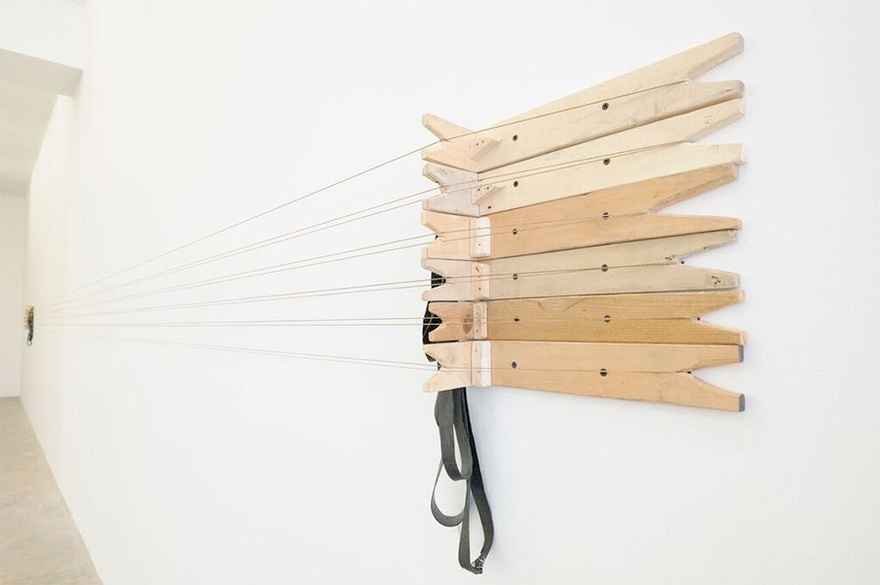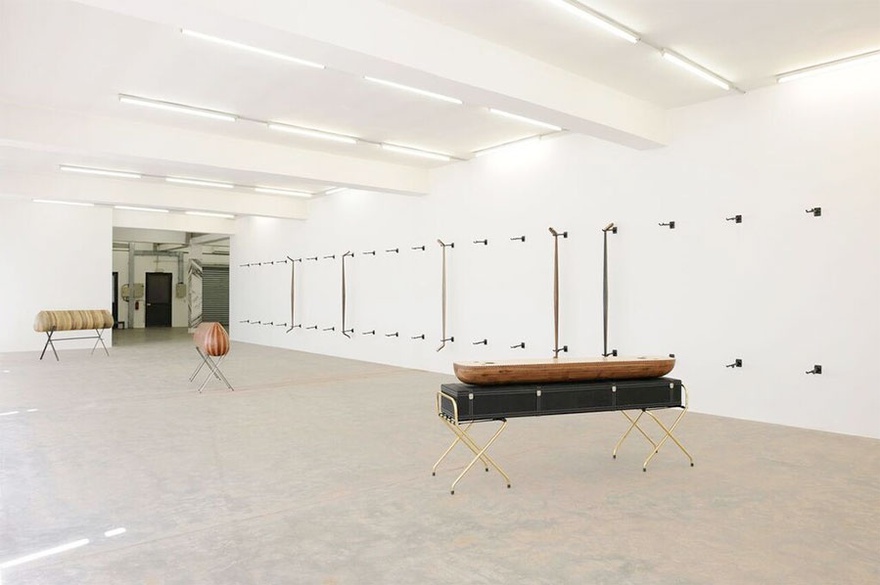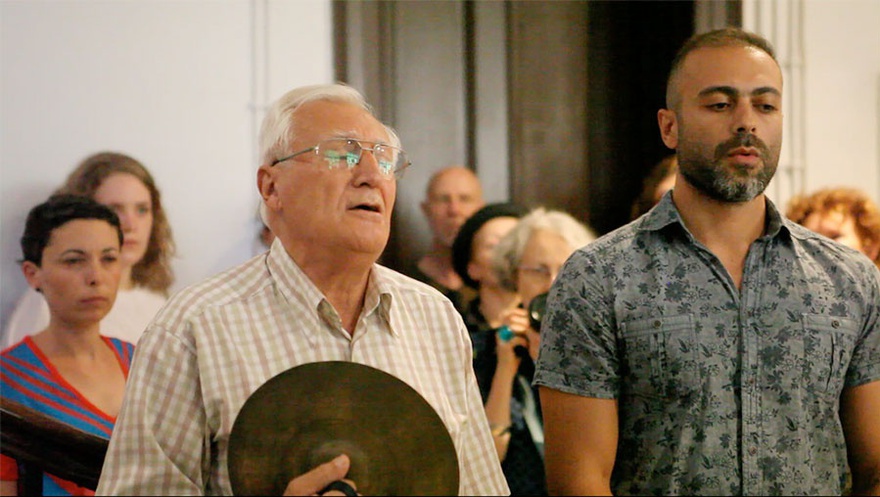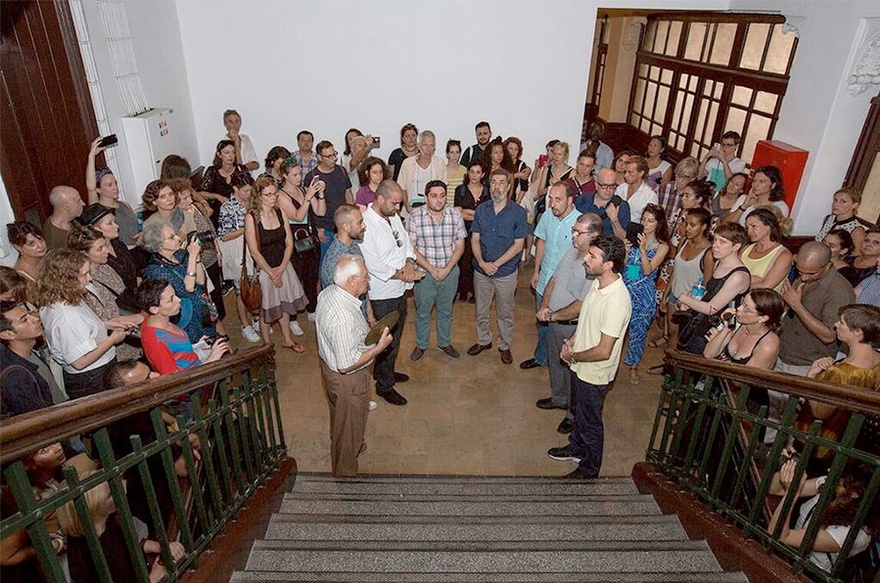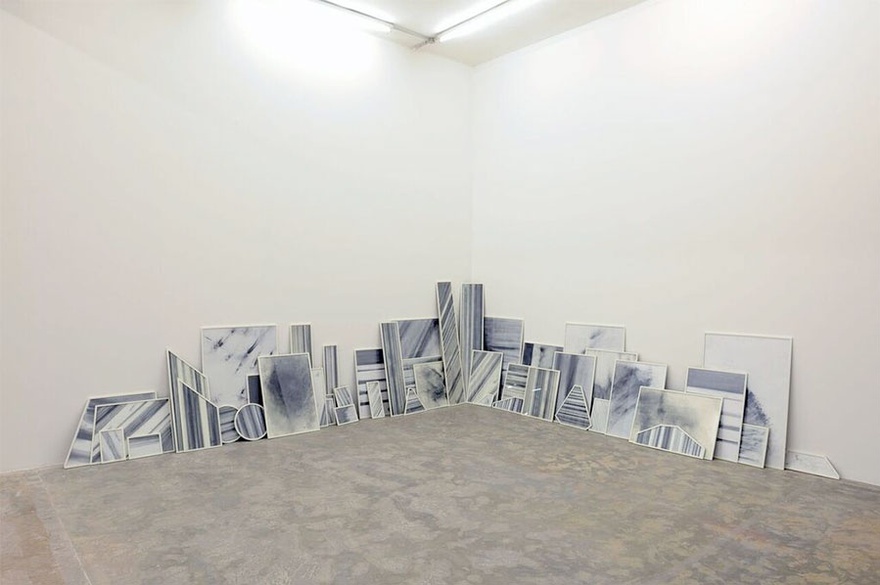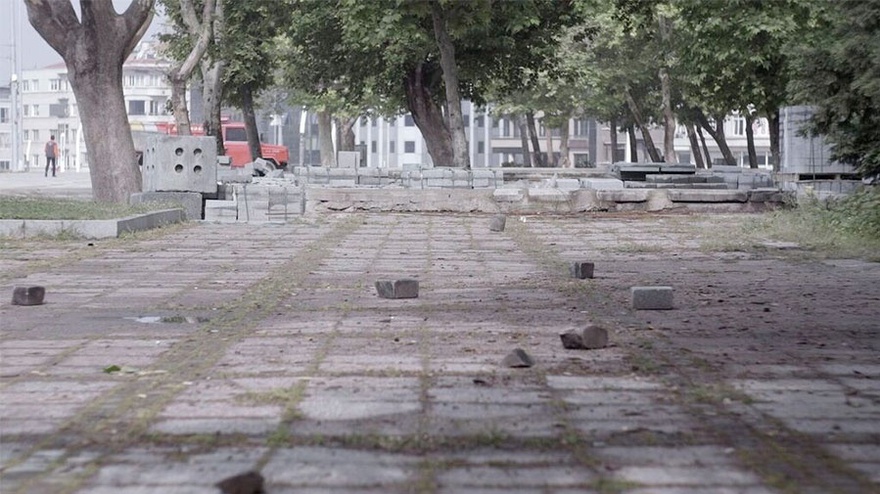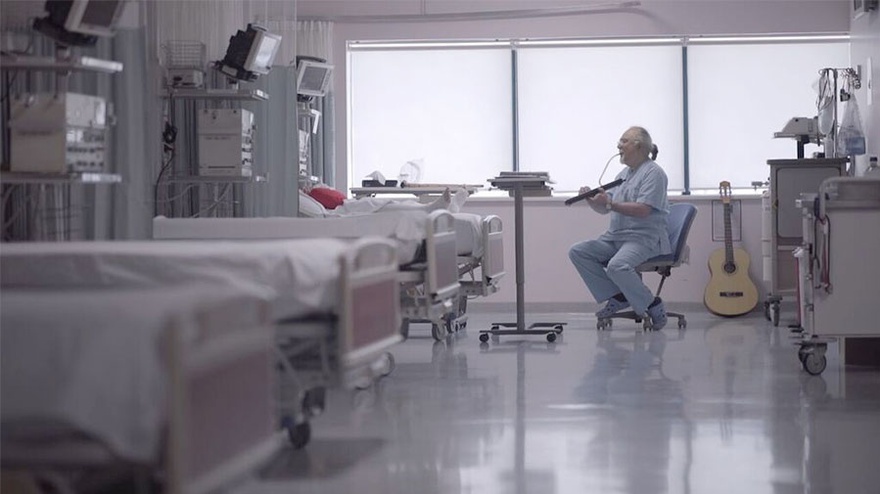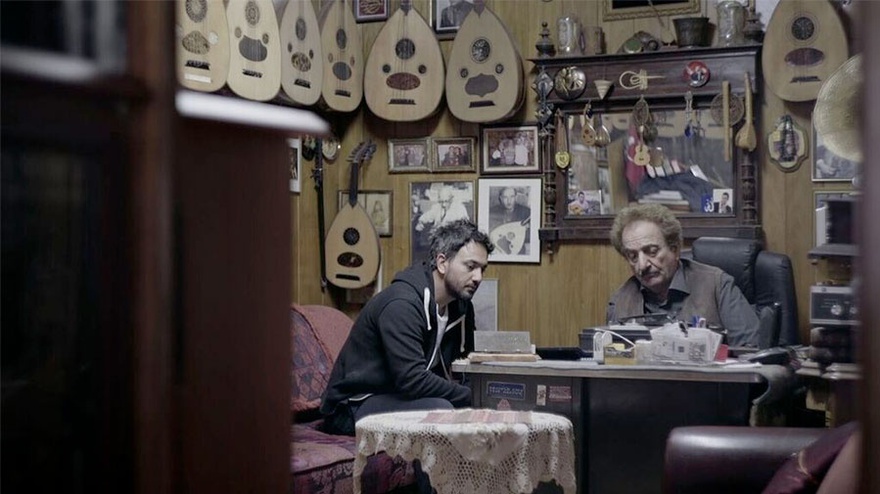Interviews
We Are Sick, But We Are Alive
Haig Aivazian in conversation with Rayya Badran
Haig Aivazian's first solo exhibition in Beirut, I am Sick but I am Alive (Hastayim Yasiyorum), which ran from 26 October 2016 to 30 December 2016 at Sfeir-Semler Gallery, drew on the artist's research into the historical and contemporary manifestations of modal 'Oriental' music in Turkey. Focusing on the legacy of Turkish-Armenian oud master Udi Hrant Kenkulian (1901–1978), Aivazian presented drawing, film, and sculpture, including iterations of the anatomy of the oud with oversized gut strings, necks and elongated bodies – an extension on a previous work from 2014, Hastayim Yasiyorum (I am sick, but I am alive), which Aivazian exhibited at the Venice Biennale in 2015. In this conversation, focusing on his Beirut show, Aivazian talks about historicity in relation to music and how it is reflected in the present, often in moments of silence. In the process, Aivazian expands on the themes that concern his practice, from the subversion of physical, historical and disciplinary borders, to the menacing and inauspicious nature of contemporary politics.
Rayya Badran: How did you discover Udi Hrant Kenkulian and how has his legacy informed the many conceptual threads running through the work you present in I am Sick but I am Alive?
Haig Aivazian: I came across Udi Hrant many years ago in the world music section of an HMV record store in Montreal. It was an album composed of taqasim – improvisations on maqamat: the melodic scales upon which the traditional 'Oriental' musical system is based – that a student of his had recorded in a hotel room in New York City in the 1970s. During one of the last songs on the album, Kenkulian interrupts his Turkish singing and suddenly announces in Armenian that he is about to play a song dedicated to his beloved student. The ornamentation and nasality of his voice rang more Arabic or Turkish to me, unlike most of the Armenian singing that I had been accustomed to hearing, which featured more heady, operatic voices. Those kinds of voices had always bothered me, especially when applied to peasant music, or worker songs: I mean, why would a peasant be singing soprano? But this tonality rang much truer to that world, somehow.
What I thought to be a disjuncture at the time was really the starting point of the research. I had instinctively identified a gap which had to do with the history of the various musics of the Ottoman Empire: their intertwinements and their forced separations. Udi Hrant lived from 1901 to 1978. He was a witness to these as well as other historical occurrences, including the downfall of the Empire and the creation of the republic of Turkey.
The founding of the republic is an era of all sorts of top down reforms; and music, being a crucial aspect of national identification, is no exception. During the initial stages of the republic in the early 1920s, Ataturk tried to ban classical Ottoman music in a bid to turn towards western classical chamber music. For him, Ottoman music was backward because it was infused with 'foreign' influence: Arabic, Kurdish, Armenian and Greek, as well as Islamic and other religious traditions. The ban had to be overturned because people were not connecting to this new music. He then devised a new approach: hordes of ethnomusicologists would be sent out into Anatolia to collect the best specimens of 'pure' Turkish folklore, recording them, re-arranging them, notating them, often Turkifying the lyrics, and so on. This meant that ancient folkloric pieces – often orally transmitted and with endless variations – that were sang in fields, streets, and homes, were petrified and stripped of improvisation. They were inscribed using western notation systems and arranged for choirs comprised of now-conservatoire trained musicians and singers. This genre, Turk Sanat Muziği – Turkish Art Music – combined the old, now Turkified Ottoman classics with chamber or salon-style music.
Within the Armenian communities of Anatolia, the ethnographic turn occurs earlier, in the late 1800s, spearheaded by an iconic figure in modern Armenian history: a priest called Komitas. Komitas was an incredibly prolific collector of music: his notes include arrangements of Kurdish and Arabic songs, among others, as well as the Adhaan call to prayer. He is also responsible for introducing western notation and polyphony into the Armenian musical traditions, sacred and profane. This shift changes Armenian music in profound ways. As I mentioned earlier, what used to bother me in contemporary renditions of Armenian music was a clearly modern operatic voice singing village or farm songs. It just didn't make sense. This is what initially drew me to Udi Hrant: his singing made sense with my Lebanese experience of Armenian culture, as being deeply ingrained in so-called Oriental musical traditions and hybrid in all its forms. Indeed, that history was immediately unraveled: I learned about legendary instrument makers, musicians, composers and so on of Greek, Jewish, Armenian and other minority origins.
But my interest is not to lay claim to a history or a music: that is a ludicrous exercise in this context. Rather, I want to hold onto an entanglement and complexity present in the common histories of music, covering the expanse of land from Greece to Iraq. A complexity ruptured by the creation of nation states, and the violences, amnesias, and erasures that came with it. The project wants to hold onto the liminal quality of soundwaves, radiowaves, and voice, as being uncontainable and by definition transversal. This quality of sound presents a potent framework linking musical histories of the region to contemporary migration waves and geopolitical maneuverings, which today are increasingly along sectarian lines.
RB: As part of the show, you displayed the sheet music and musical notes from the choral performance of Kenkulian's Wavy is the Sea of Bolis, O Mother, which you staged as part of the 2015 Istanbul Biennale. How do the notations presented in your Beirut exhibition link to the Istanbul performance?
HA: For the 14th Istanbul Biennial, I collaborated with the choir of the Holy Trinity Church located in the fish bazaar of the Beyoglu neighborhood. I was interested in working with them, as they sang and taught liturgy using Ottoman Maqams, and Hamparsum Notasi, the notation system widely in use prior to Komitas's introduction of western notation, while maintaining the traditional method of master-student transmission. In my conversations with choir members, I found out that Udi Hrant had also worshipped there. He had requested that a recording of his oud rendition of 'Der Voghormia', the quintessential prayer in Armenian liturgy, be played on loudspeakers as his coffin was carried out of the church. Sadly, I have not managed to locate that recording, but the important point is that many hybrid musical and cultural practices and occurrences were present in this place and had been so historically.
The location of the performance was a beautiful building that used to be a Greek school, gradually emptied and abandoned due to the various pogroms and population exchanges endured by the Greeks of Istanbul. Along with the profound Greek legacy in Oriental music, I thought that these waves of migration were a powerful parallel with the Armenians in Turkey. There were many musical parallels as well: Greeks, too, were legendary oud makers in Istanbul, they also had a notation system of their own, Hrisantos Notasi, and had the more virtuosic contemporary to Udi Hrant, Udi Yorgo Bocanos.
The performers sang one of Udi Hrant's recordings, an appropriation of a folkloric song from Egin in the Erzincan region of Turkey. The original was a women's work song in Turkish, lamenting the departure of their men who had gone to seek employment in the city. Kenkulian's Armenian version changes the voice to that of a man yearning to be reunited with the woman he loves so that he may throw himself into the wavy sea of Bolis, a term used by Greeks and Armenians to refer to Istanbul. Thinking through the theme of water of the biennial, I imagined the bodies of the choir members being largely comprised of water, moving up the central stairs of the Greek School, a flood, momentarily repopulating the abandoned building.
The performance was structured along solos which took place on the landing of each of the four floors, while the chorus was sung collectively as the choir walked up the central staircase – the spine of the building. The choir members would stand in a semi-circle facing one another; surrounded by the audience like a cypher. The spatial, emotional and acoustic charge of the moment made it an inherently corporeal experience, one that was difficult to document.
I chose to include the musical notes as an intriguing trace of the performance for the show in Sfeir-Semler in Beirut. There are two frames: one containing the Hamparsum Notasi and the other western notation. Due to a shortage of qualified singers, the master singer recruited back-up singers from other churches in Istanbul, a couple of which were not familiar with modal singing as they were conservatoire trained. The conversations which took place for them to be able to learn this piece and sing it together, revealed the gaps in understanding between these two schools of the same liturgy.
RB: The notations reminded me of Pierre Huyghe's Score of Silence (1997) in which the artist displays a musical score for John Cage's seminal 4'33", first performed in 1952. In this piece, Huyghe notated the noises of 'silence' from the recording of Silence in 1961. Your notations, however, intend to transcribe a confluence of voices in rehearsal for something that was left behind and remains irreconcilable; they include notes and annotations marked in red and written in Armenian, presumably to translate the composition for the singers unfamiliar with the modal tradition, of which there are no translations offered to the public. In a way, these notations become archives for something that was only recently excavated; a 'dead letter' for voices that were silenced. If it was impossible to transcribe or transpose the affective aspect of the performance, it feels like we are reburying those voices again.
HA: I do not think that I am attempting to excavate or salvage anything per se. I am more interested in exploring the contemporary strangeness of affected musics, constituted from the floating remnants and traces of a past that still hangs around, and that floats back to the surface at every turn. By extension, the sculptures are affected instruments that have become morphed by history, and that reflect the migratory nature inherent in the structure of modal music: the takasim, which depart from one maqam, to another, until returning to the original maqam from which it started. As for the notes, they were historically not used as tools for playing or learning music. Writing down music, like any act of writing history, is couched in the rhetoric of preservation, while in practice, is often reductive and constraining. If indeed these histories are a haunting of some kind, they are not constituted of ghosts that are waiting to be summoned from some other dimension. These are rowdy ghosts, out and about in our world, whose presence is seen in every reflection of the city, whose voices inhabit every musical utterance, and not just the disembodied ones which come to us from recordings past.
RB: The material of marble is of paramount importance in two new series included in the exhibition: Cladding I,II and Column which are large pastel on paper studies of marble slabs, and Tiles, which includes 45 irregularly shaped and framed graphite on paper drawings of various dimensions that evoke the forgotten chunks of marble dispersed in the city of Istanbul. How did you come to unpack the historical usage of marble in modern Turkey?
HA: When I first went to the Holy Trinity Church in Beyoglu, I noticed the uneven shapes and sizes of the tiles in the courtyard. I was told that they were transferred from a cemetery – which used to be where Gezi Park currently stands – destroyed to make room for the construction of the park, Taksim Square, and Istanbul Radio. The area would turn into the new centre of Istanbul. This appropriation of marble existed throughout the Ottoman Empire, where the reuse of architectural elements from antiquity was common practice. A famous example that Ussama Makdissi writes about is the transportation and integration of one of the columns of Baalbek into the façade of a bank in Istanbul.
I also kept thinking of Roger Caillois' The Writing of Stones, who sees in the natural motifs in rocks, the 'geological anticipations' of the urban landscapes that would come in the future. Caillois talks about this geology as holding 'a presentiment of a universal syntax'. Through such a scope, one can read a layering of various timescales into the marble: from geological notions of time to traces of a modern history. The marble in this way was similar to Hellenistic thought about music linking the laws of the universe to human creation: a geologico-architectural manifestation of a ruptured continuum. All of these approaches were all the more interesting to me, as they placed the mechanisms that drive history outside of a purely human will.
In my initial trips to Istanbul, I of course went to Hagia Sophia, where like in many Byzantine churches, you see these famous bookended marble slabs encrusted into the walls. I was particularly intrigued by some of these panels, which for whatever reason, rarity of the stone or financial shortage for example, had been replaced by hand-painted reproductions of the patterns of the ornate marble. They made me think of Mies Van Der Rohe's preparatory drawings for the marble walls in his Barcelona Pavilion. Later at a lecture by Art Historian Finbarr Barry Flood in Beirut, I learned that these connections were not coincidental at all. Modernist architects, like Van Der Rohe and others, were looking at the architecture of antiquity not just in the surface proximities such as ones present in marble, but in integral and structural ways. Hagia Sophia for its formal, social and ideological qualities was and continues to be a particularly important influence for modern architects. There are also artistic examples more closely resonant with my project, such as Malevich's interest in Eastern liturgical traditions in his quest to find the distilled essence of iconography.
I very much liked the time collapse that this reflection around marble was offering me: drawing the marble was on the one hand a preservation, care and revival, while Mies was drawing marble as planning, predicting, preparing. Adding Caillois to this mix really turned marble into a transhistorical witness shaped and sculpted by the very histories it is witnessing. My own act of drawing was a reference to this impoverished form of preservation. It was also a reflection on repetition, explored in two sets. The first, departing from this symmetrical marble cladding, was three large-scale pastel murals. These were not mechanically reproduced, like prints of a record might be, but rather a manual attempt, full of inaccuracies, differences, off notes, mistakes and so on; like multiple takes of the same piece on a jazz album. The second was an accumulation of framed graphite drawings in various shapes and sizes, leaning against the wall, overlapping one another, like a storage of a showroom. These were based on the idea of the dispersal of the marble into the city.
A final note on drawing as a conceptual practice: the idea of drawing these marbles is not an attempt at representation, nor is it just an inhabiting of existing forms of drawing, like those of the restorers. But I think drawing is, as Berger claims, more corporeal than any other art form. I am very much interested in his position that drawing arises out of the need to answer the ontological question: 'where are we?' Michael Taussig in his reflections on his own ethnographic field drawings refers to this, but he also likens drawing to getting to know or to see the world by outlining. The drawer is present in the space that s/he outlines and gets to know it as s/he draws its contours, in the way that a visually impaired person gets to 'see' someone by running her/his hands over one's facial features. The process of drawing contains within it time, and it also has the ability to conjure up and make visible a ghostly absence.
RB: I've come to understand the omnipresence of marble as an inability to recognize the ruin, because its fragments were stitched onto a homogenizing urban landscape. Perhaps ruin is a loaded word here, but I was wondering whether it is fitting to talk about ruins in relation to the trace – not only by way of reproduction, of tracing lines and also traces of ever-present wounds, but most importantly by how it also relates to hybridity as form of violence.
HA: Absolutely, the marble is a seam: it ties together but also marks interruptions in sense. It is a self-declaring surface to put it in modernist terms – literally its veins and layers tell its composition – but it is also in this context a perpetually babbling witness, telling of a destruction of one place, and the refurbishment of another. I was also thinking of the marble in a forensic sense, and thinking about the evolution of recording technologies and the effect of this evolution on architecture. In other words, what happens to architecture when it no longer needs to amplify sound? I was talking to Lawrence Abu Hamdan about this: he has this project about various everyday products which have a muscle memory of sorts, absorbing the micro vibrations caused by the sounds around them. These micro vibrations can then be extracted and turned back into sound. I thought, if marble had this quality, what would these tiles sound like when we extract the centuries of musics, sounds and histories they have absorbed? Of course marble absorbs very little sound in fact, hence the wonderfully cavernous nature of the acoustics of Hagia Sophia.
But this idea became particularly resonant in my mind once I visited the headquarters of Istanbul Radio, which was a part of the same development that precipitates the destruction of the cemetery: a sort of neo-fascist, neo-neoclassical building, the insides of which are entirely clad in the very same marmara mermeri marble as the courtyard of the church in Beyoglu. Then once you are looking for these layers suddenly they just turn up everywhere, right? It's how conspiracy theories become so obsessively convincing. The cemetery happened to include the grave of Hamparsum Limonciyan (1768–1839), the person credited with developing the Hamparsum notation system out of the ancient but forgotten khaz notes. So here the marble is a literal materialization of the musical histories I was researching, the erasure of the pre-modern in Hamparsum, whose grave is forever lost in the destruction, and the creation of the modern in the radio building.
RB: The 46-minute film Not Every Day is Spring, which provides an audiovisual exploration of the music, landscape and politics you encountered in Istanbul, gives voice to the research behind the show. Like a gasp, the film stands in contrast to the weight of silence perceived in the rest of the exhibition. This makes me wonder about the act of listening and the posterity of recordings. How did you go about selecting the songs that are featured and performed in the film? And, if recording is, however nominally, about prolonging the life of voices and music, how is this legacy regarded today?
HA: The criteria are somewhat multiple. On one level, the film loosely follows in the footsteps of Udi Hrant as a structure through which to paint a musical portrait of Istanbul. This portrait is juxtaposed with the trails of the dispersed marble slabs of the cemetery as they are now integrated into architectures of the city. The film is essentially comprised of a series of musical performances, which often seem like an out of place encounter. They are interspersed with shots of Gezi Park, and long tracking shots of the various marble floors of the locations in the narrative. These pans are generally paired with subtle sounds of radio frequencies, as if they are being transmitted by the stones themselves. The songs are either ones composed or played by Udi Hrant, or they are other folkloric melodies which exist in multiple versions, in different languages and musical traditions.
Rather than a straight narrative structure, what I tried to do with the film is to weave a motif of displacement, be it the melodic displacements of these songs, or the construction materials in the city in constant motion. There are two more abrupt disruptions, found footage of landscapes shot with phones or camcorders looking out to the eight countries bordering Turkey. Here again we hear wandering radiowaves, traversing the borders, impregnating the landscape. These waves then move through the landscaping in the city, the architecture, the bodies of the musicians and the body of the viewer.
One of the performances is by MoodBand Syr: a group of street musicians comprised of Syrian asylum seekers. They perform Fattoum Fattoum Fattoumeh: a song made famous in Syria and Lebanon by Dored Lahham's Ghawwar el Toche character, sang in the 1975 film called Sah el Noum, anoffshoot from the seminal TV series. Armenians know this song as Karoun Karoun Karouneh, an extremely popular children's song. Turks know the melody as Mavi Boncuk, made famous in a 1975 film of the same name by singer Emel Sayın. There are also Azeri and Greek versions of the song.
Similarly, the piece played by Dr. Erol Can, an anesthetist who practices music therapy for patients recovering from heart surgery in intensive care, is another melody shared by various communities. The original is attributed to Azeri composer Alakbar Taghiyev, which was then taken up by Azeri singer Sibel Can, and made famous by Turkish singer Gülay Sezer, with literally tens of other versions. The film's first performance, by Sedat Oytun, TRT's – Turkey's state radio, which Istanbul Radio is a part of – first oud soloist, is a Udi Hrant composition that was taken up by many Turkish singers, including the legendary Zeki Müren. The song is called Hastayim Yaşiyorum, or 'I am sick, I am living', which inspired the title of the project I am Sick, But I am Alive.
In a sense, the performances are an anti-recording, in that they are a testimony to the multiplicity of these songs; a testimony of what records exclude from history just as they concretize it, and to the impossibility of the original.
RB: And perhaps working against the idea of authenticity in music as well? How do you activate the writing of history through music as an artist?
HA: A big part of the reason why there is no voice-over, or in effect very little factual or historical information in the film, is based on the premise, or the gamble. that the music carries within itself already – within the timbre of voices, the resonance of notes, crackles of strings and so forth – the profound histories which create it. That the music itself can tell those histories which are otherwise impossible to be told by written histories. Authenticity is a modernist value: it ruptures traditions as it moves forward, and places tradition, authenticity, purity in the inaccessible and petrified past. But music is not petrified, and it is very difficult to place any part of it in the past. Bachelard claims that every one of our interactions with fire, as normalized and scientifically explained a 'technology' as it may be today, are somewhere within them shaped by the initial terror, surprise, and awe felt by the human's first 'discovery' of fire. This idea gains amplification when I imagine it in relation to the discovery of music, if one can speak of such a thing: the idea that in the same way as our eyes glaze over in a hypnotic state around a fire, the effect that music has on our emotions is caused by some sort of accumulation of every musical note ever played.
RB: The shots of Gezi Park, Taksim Square and other public spaces in Istanbul are desolate. They are bleak and devoid of life and are contrasted by the very warm fixed shots of the series of singers and musicians performing in the film. The film oscillates between the past, which is represented aurally, and the present, which is translated into the shots of the city, with the marble holding everything together. The film is almost Frankensteinian, where the work ruins its originator. But since the project rests on unearthing voices that were otherwise stifled, the voices of the people who populated Gezi during 2013 also remain conspicuously silent; was that a concern of yours?
HA: I love this reading of the film: this flimsy stitching together of past and present as an awkward creature. I would just not segregate the past and present or assign them to one or another kind of shot. I think all of the shots contain multiple temporalities within them. Gezi is the modern development that erases the ancient cemetery, but in 2013 it becomes an archeological ruin to be preserved and protected from another layer of destruction seeking to turn it into a mall. The protests stopped the construction of a mall, but didn't prevent all the park's trees from being cut. When I first saw Gezi, I was surprised by its modesty, as well as the power that these cut trees had come to embody.
I looked at the monument to the Republic, just across from the park and compared it to the tree stumps that remained, and found that the stumps formulated a more contemporary and effective sculptural language. It was therefore implicit that choosing to centre the whole film on a constant return to Gezi was a political choice, and the stifled voices of Gezi, like the erasures in the music, are never fully silenced. The fact that the very utterance of the name Gezi now immediately conjures up resistance is a testament to this. The protests started when people rushed to stop bulldozers already at work in the destruction of the park. This process already had exposed some remaining stones from the Pangalti cemetery underneath, which were infused with renewed power as symbols of resistance and loss. The contemporary and history are inextricably intertwined: nothing is erased. It is all a constantly and ever-evolving palimpsest.
Haig Aivazian is an artist living in Beirut. Working across a wide range of media, he delves into the ways in which ideologies embed, affect and move people, objects and architecture. Often departing from known events, and weaving in lesser known narratives, he has explored apparatuses of control and sovereignty at work in sports, finance, museums and music.
He has exhibited in FRAC Aquitaine, Montreal and Marrakech Biennials (2016), The Istanbul Biennial and Armenian Pavilion at the Venice Biennial, The Museum of Modern Art Warsaw (2015), Asia Society New York, the Kölnischer Kunstverein (2014), VideoBrasil Sao Paulo, Homeworks Beirut (2013), FIDMarseille (2012), Mercer Union Toronto (2011). He curated Roads Were Open / Roads Were Closed, The Third Line Dubai (2008) and was Associate Curator of the Sharjah Biennial (2011). He has written for Afterall and Manifesta Journals, Bidoun and Makhzin, and has taught at the American University of Beirut and the Ashkal Alwan HomeWorks Programme. His latest film Not Every Day Is Spring will be in the Forum Expanded section of the Berlinale (2017).

